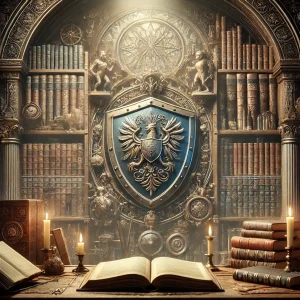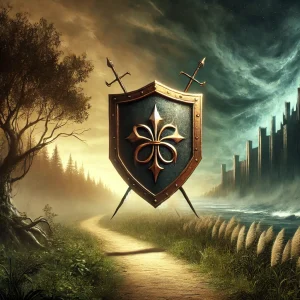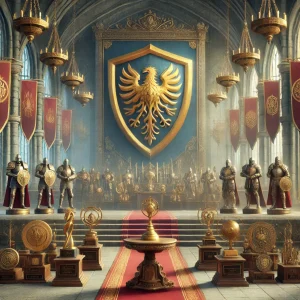Introduction to "The Rising of the Shield Hero"

"The Rising of the Shield Hero" follows Naofumi Iwatani, a typical otaku who finds himself transported to a parallel world. Unlike most heroes, Naofumi is chosen as the Shield Hero, a role that seems less glamorous compared to others wielding swords, spears, and bows. His adventure, however, is far from ordinary.
Imagine being thrust into a new world, full of magic and monsters, only to be betrayed by those you thought were allies. That’s what happens to Naofumi right from the get-go. He’s falsely accused of a crime and left with nothing but his shield and his wits. This twist sets the stage for an epic tale of redemption and growth.
"The Rising of the Shield Hero" didn’t start as an anime. It all began as a light novel series written by Aneko Yusagi. The story was so captivating that it quickly expanded into a manga, illustrated by Aiya Kyu. These adaptations laid a strong foundation, gaining a loyal following eager to see the world of Naofumi brought to life in animation.
When the anime adaptation finally premiered, it took the fanbase by storm. Kinema Citrus, the studio behind the adaptation, did an outstanding job bringing the story’s rich world and complex characters to the screen. The animation quality, coupled with an engaging soundtrack, added depth to an already powerful narrative.
What’s fascinating is how "The Rising of the Shield Hero" has resonated with audiences worldwide. It’s not just popular in Japan; it has a massive following in the US, Europe, and other parts of Asia. Fans connect with Naofumi’s struggle and resilience, making the story relatable on a universal level.
Part of this global appeal is due to the series' accessible themes. Betrayal, perseverance, and growth are universal experiences. Watching Naofumi overcome adversity and build a new family with characters like Raphtalia and Filo is inspiring. These characters are not just sidekicks; they have their own stories and growth, adding layers to the main narrative.
Plot Overview

Our adventure begins with Naofumi Iwatani, an ordinary guy who suddenly finds himself transported to a parallel world. Sounds cool, right? But here's the catch – he’s summoned as the Shield Hero, one of the four legendary heroes tasked with saving the world from catastrophic Waves of Calamity. While the other heroes get offensive weapons like a sword, spear, and bow, Naofumi is left with just a shield.
Naofumi’s journey is anything but smooth. Right off the bat, he’s falsely accused of a heinous crime by Princess Malty, leading to his complete social ostracization. With no friends, no money, and no trust, Naofumi is forced to fend for himself. He’s bitter and angry, but he doesn’t give up. Instead, he buys a demi-human slave named Raphtalia to aid him in battle. Together, they start to fight back against the Waves, gradually becoming stronger.
One of the first major arcs is Naofumi’s initial struggle for survival. This part of the story focuses on how he overcomes betrayal and starts building his strength. With Raphtalia by his side, he slowly gains power and begins to restore his reputation. Their bond deepens as they face numerous challenges, and Raphtalia’s transformation from a scared little girl to a fierce warrior is truly heartwarming.
Next, we move to the battle against the Waves. These are catastrophic events that bring hordes of monsters into the world, and it's up to the heroes to stop them. Naofumi’s strategic mind and the support of his growing party, including the energetic Filo, a Filolial Queen, play a crucial role in these fights. Their teamwork and trust in each other are put to the test as they confront increasingly powerful foes.
Another key arc is the confrontation with the other heroes. Naofumi’s relationship with the Sword, Spear, and Bow Heroes is rocky, to say the least. They often underestimate him and clash over methods and morals. However, as they face greater threats, there’s a slow but steady shift towards cooperation. It’s fascinating to watch this dynamic evolve as they learn to respect Naofumi’s strength and leadership.
One of the most significant twists comes with the revelation of the true nature of the Waves. They’re not just random disasters but are orchestrated by powerful entities with their own agendas. This adds a whole new layer of complexity to the story. Naofumi and his companions must not only fend off these attacks but also uncover the underlying conspiracy.
Another major event is the showdown with the Church of the Three Heroes. This corrupt institution has its sights set on eliminating Naofumi. The tension culminates in a dramatic battle where Naofumi's true power and the loyalty of his friends shine through. It’s a turning point that significantly shifts public perception and marks a new chapter in his journey.
We also can’t forget the emotional depth brought in by the character backstories. Raphtalia’s traumatic past, Filo’s innocent yet fierce loyalty, and Naofumi’s gradual healing from betrayal all add rich layers to the narrative. These moments are woven seamlessly into the action, making the story both thrilling and deeply moving.
Character Analysis

First up, we have Naofumi Iwatani. Imagine being summoned to a new world and immediately betrayed. That’s Naofumi’s starting point. He’s the Shield Hero, one of four legendary heroes tasked with saving the world. But unlike the others, he’s framed for a crime he didn’t commit, leaving him bitter and distrusting. His journey from a cynical outcast to a true hero is both heart-wrenching and inspiring.
Next is Raphtalia. She starts as a scared, malnourished demi-human slave but quickly becomes Naofumi’s most loyal companion. Her transformation is incredible – from a timid girl to a fierce warrior, all the while retaining her kindness and sense of justice. Raphtalia’s growth is a testament to her inner strength and resilience.
Then there’s Filo, a Filolial Queen who appears as a giant bird and a little girl. She’s energetic, loyal, and fiercely protective of Naofumi and Raphtalia. Her innocence and childlike wonder bring a refreshing contrast to the darker aspects of the story. Despite her playful nature, Filo proves to be a formidable fighter in battles.
Naofumi’s development is central to the plot. Initially, he’s driven by anger and a desire for revenge. But as he builds his party and faces various challenges, he starts to change. Naofumi learns to trust again, especially through his bond with Raphtalia and Filo. His strategic mind and unwavering determination turn him into a leader who earns respect from friends and foes alike.
Raphtalia’s role is pivotal. She’s not just Naofumi’s sword; she’s his emotional anchor. Her unwavering loyalty and belief in Naofumi help him heal from his emotional wounds. Raphtalia’s journey is one of empowerment. She overcomes her traumatic past and becomes a symbol of hope and strength, inspiring others to fight against injustice.
Filo, on the other hand, brings a light-hearted dynamic to the group. Her role is multifaceted – she’s both a powerful fighter and a source of joy. Filo’s innocence often brings out Naofumi’s softer side, showcasing his ability to care deeply despite his tough exterior. Her unique abilities also play a crucial role in battles, proving that even the most playful characters can be essential to the team’s success.
The relationship between Naofumi and Raphtalia is at the heart of the series. It’s a bond built on trust, mutual respect, and shared experiences. Raphtalia’s unwavering support helps Naofumi regain his faith in people, while Naofumi’s guidance and protection allow Raphtalia to grow strong and confident. Their dynamic is both touching and powerful, showcasing the best of what a partnership can be.
Filo adds another layer to this dynamic. Her childlike innocence and boundless energy bring out different sides of both Naofumi and Raphtalia. Naofumi acts as a protective father figure to her, while Raphtalia often plays the role of an older sister. This trio forms a unique family unit, with each member contributing to the others’ growth and happiness.
The interactions with other heroes also add complexity to Naofumi’s character. Initially, there’s a lot of tension and distrust, particularly with the Spear Hero, Motoyasu. However, as the story progresses, there are moments of reluctant cooperation and mutual respect. These relationships highlight Naofumi’s ability to adapt and lead, even in the face of adversity and misunderstanding.
Themes and Motifs

One of the most striking themes in "The Rising of the Shield Hero" is betrayal. Right from the start, Naofumi is betrayed by Princess Malty and falsely accused of a crime. This betrayal sets the tone for his journey and profoundly impacts his character. Naofumi’s initial trust in the world is shattered, leaving him isolated and mistrustful. This theme of betrayal isn't just a plot device; it’s a driving force that shapes Naofumi’s actions and decisions throughout the series.
Following closely on the heels of betrayal is the theme of redemption. Naofumi’s journey is not just about fighting monsters; it’s about redeeming himself in the eyes of the world and proving his worth. His path to redemption is fraught with challenges, but it’s also deeply rewarding. Through his actions and determination, Naofumi slowly rebuilds his reputation and earns the trust of those around him. Redemption in this series is portrayed as a hard-earned but immensely satisfying process.
Growth is another central theme, and it’s beautifully intertwined with Naofumi’s character development. Initially, Naofumi is filled with anger and bitterness, but as he builds his party and faces various challenges, he begins to grow. This growth is not just about gaining strength or skills; it’s about emotional and psychological development. Naofumi learns to trust again, forms deep bonds with his companions, and ultimately transforms into a true hero. The theme of growth is portrayed through both the characters’ individual journeys and their evolving relationships.
Betrayal is vividly portrayed through Naofumi’s early experiences. The false accusation and subsequent isolation make his journey incredibly personal and emotional. This theme is reinforced by the actions of other characters, such as Princess Malty’s continuous schemes and the initial distrust from the other heroes. The series uses betrayal to highlight Naofumi’s resilience and to set up his journey towards redemption.
Redemption is portrayed through Naofumi’s actions and the gradual change in how others perceive him. Key moments, such as his selfless acts during the Waves and his efforts to protect the weak, showcase his true character. The series does a fantastic job of showing that redemption is not instantaneous but requires continuous effort and sacrifice. Naofumi’s redemption arc is one of the most compelling aspects of the series, as it shows his transformation from a pariah to a respected leader.
Growth is depicted through the characters’ interactions and personal challenges. Naofumi’s growth is mirrored by Raphtalia’s transformation from a frightened slave to a brave warrior and Filo’s evolution from a playful creature to a powerful ally. These characters’ growth is portrayed through their actions, decisions, and the bonds they form. The series emphasizes that growth is a collective journey, influenced by the support and trust of others.
The themes of betrayal, redemption, and growth have a profound impact on the audience. The initial betrayal that Naofumi faces evokes strong emotions, making viewers empathize with his plight. This emotional connection keeps the audience engaged and invested in his journey.
Redemption, as portrayed in the series, offers a sense of hope and satisfaction. Watching Naofumi overcome his challenges and redeem himself inspires viewers to believe in the possibility of second chances and personal transformation. It’s a powerful message that resonates with many, encouraging perseverance and resilience.
Growth, both personal and collective, is a theme that many viewers find relatable. The characters’ development and evolving relationships highlight the importance of trust, support, and continuous effort. This theme encourages viewers to reflect on their own growth and the role of their relationships in their journey.
Reception and Impact

When "The Rising of the Shield Hero" first aired, it immediately sparked a lot of discussions. Critics and fans alike had a lot to say about Naofumi’s tumultuous journey. Some critics praised the anime for its unique take on the isekai genre, where the protagonist isn't the typical overpowered hero but someone who has to claw his way up from the bottom. This fresh perspective garnered a lot of positive attention.
Fans, on the other hand, were captivated by the emotional depth of the story. Naofumi’s initial betrayal and subsequent struggle for redemption struck a chord with many viewers. The character development, especially that of Raphtalia and Filo, was another highlight that fans couldn’t stop talking about. Their growth and the evolving dynamics with Naofumi made the series engaging and relatable.
However, it's worth mentioning that the series wasn't without controversy. The initial episodes, particularly the false accusation of Naofumi, stirred up some debate. Some viewers found it uncomfortable, while others appreciated the bold narrative choice for its emotional impact. Despite this, the overall reception has been overwhelmingly positive, with a loyal fanbase eagerly following Naofumi’s journey.
"The Rising of the Shield Hero" didn’t just capture hearts; it also caught the eye of award panels. The anime received several nominations and accolades, solidifying its place in the anime community. For instance, it was nominated for the prestigious Crunchyroll Anime Awards in multiple categories, including Best Fantasy and Best Protagonist for Naofumi Iwatani. These recognitions highlighted the series' strong storytelling and character development.
The voice actors also received praise for their performances, adding another layer of depth to the characters. Their efforts didn’t go unnoticed, with many earning accolades for their contributions to bringing the characters to life. This level of recognition speaks volumes about the quality of the series and its impact on viewers.
Now, let’s talk about the broader influence of "The Rising of the Shield Hero." The series has significantly impacted pop culture, extending beyond just the anime community. Merchandise ranging from figures and apparel to video games has flooded the market, allowing fans to engage with the series in various ways. The characters, especially Naofumi, Raphtalia, and Filo, have become iconic, often featured in cosplay and fan art across conventions worldwide.
The influence doesn't stop there. "The Rising of the Shield Hero" has also inspired other media, including spin-off novels and manga. These extensions of the original story have helped maintain and expand its fanbase, keeping the world of Naofumi and his companions alive and thriving.
In addition, the anime has sparked numerous discussions and analyses online. Fans regularly dissect episodes, explore character arcs, and theorize about future developments. This level of engagement demonstrates the series' profound impact, encouraging a vibrant and active community.
Interestingly, the series’ themes of betrayal, redemption, and growth have resonated beyond just entertainment. They’ve sparked conversations about resilience and the power of perseverance, showing that "The Rising of the Shield Hero" is more than just an anime; it’s a narrative that inspires and challenges its audience.
So, if you haven't checked out "The Rising of the Shield Hero" yet, you're missing out on a significant piece of contemporary anime culture. Its reception and impact are a testament to its compelling storytelling and the deep connections it fosters with its audience. Dive in, and you might just find yourself joining the ranks of its dedicated fans.
